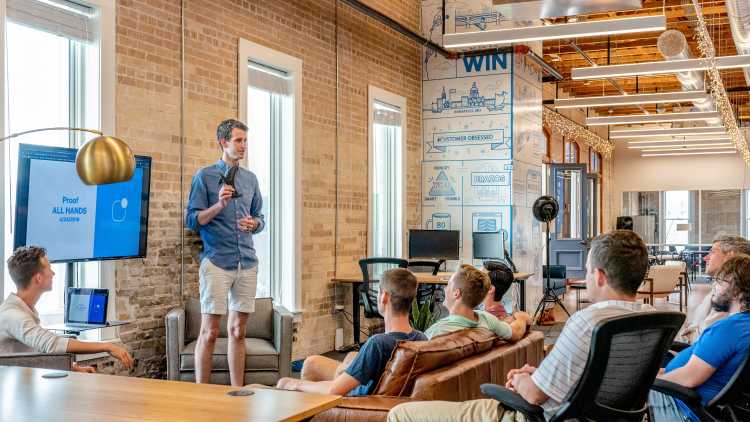Communities & Memberships
31 Community Engagement Ideas (+ Examples)
If you're looking to get your community engaged, these ideas will help you grow.
Author
Mighty Team
Last Updated
May 28, 2025

Table of Contents
- Truths about community engagement
- 31 Community engagement ideas
- 1. Customize the new member experience
- 2. Have real conversations
- 3. Charge more
- 4. Create subgroups
- 5. Go live… a lot!
- 6. Use low lifts
- 7. Try a recommendation post
- 8. Email updates
- 9. Go app first
- 10. Incorporate play
- 11. Know your Big Purpose
- 12. Your Ideal Member
- 13. Fill out member profiles
- 14. Monthly themes
- 15. Yearly plans
- 16. Moderate that thing
- 17. Build rituals
- 18. Ask questions
- 19. Introduce people
- 20. Assign a welcome committee
- 21. Go on quests
- 22. Unscript
- 23. Empower your best people
- 24. Host virtual events
- 25. Host in-person events
- 26. Invite high-profile guests
- 27. Spotlight members
- 28. Spotlight members on social channels
- 29. Incentivize engagement
- 30. Check your stats
- 31. Use a great platform
- Ready to start?
In this article
- Truths about community engagement
- 31 Community engagement ideas
- 1. Customize the new member experience
- 2. Have real conversations
- 3. Charge more
- 4. Create subgroups
- 5. Go live… a lot!
- 6. Use low lifts
- 7. Try a recommendation post
- 8. Email updates
- 9. Go app first
- 10. Incorporate play
- 11. Know your Big Purpose
- 12. Your Ideal Member
- 13. Fill out member profiles
- 14. Monthly themes
- 15. Yearly plans
- 16. Moderate that thing
- 17. Build rituals
- 18. Ask questions
- 19. Introduce people
- 20. Assign a welcome committee
- 21. Go on quests
- 22. Unscript
- 23. Empower your best people
- 24. Host virtual events
- 25. Host in-person events
- 26. Invite high-profile guests
- 27. Spotlight members
- 28. Spotlight members on social channels
- 29. Incentivize engagement
- 30. Check your stats
- 31. Use a great platform
- Ready to start?
If you've ever run a community, whether online or in real life, you've learned something. Getting people to show up in a community is great. But getting them engaged and excited is even better.
And that can be a challenge. Studies show that most communities are driven by a small segment of engaged members. Online communities can have up to 90% of people who are "lurkers."
If you're struggling to generate that all-important community engagement, this article will share some community engagement ideas that you can try this week!
If you want more support in building your online community, come join OUR Mighty Community for free and meet other new and established community owners! We’d love to meet you. Join for free!
Truths about community engagement
To help frame these community engagement ideas, there are a few things we need to understand first.
Engaged community members learn more: Community members who engage have better learning outcomes.
Engagement and satisfaction go hand in hand: Research shows that engagement and community satisfaction are closely related.
Engagement means better feedback: A 2018 study of brand communities found that engaged members left more feedback AND positive feedback (e.g. online reviews).
Engagement feels like personalization: People who engage in brand communities feel like they are getting a personal experience (even if they're not).
Lurkers feel like they belong. It's easy to feel like you're failing as a community leader when people don't engage. But research shows most lurkers are perfectly happy, and they still see the community as part of their identity. Don't treat lurkers like they're doing something wrong or failing (e.g. "Why haven't you posted anything?"). Instead, find ways to draw them out on their terms.
Lurkers complain about tech. Another study of lurkers found that they tended to complain more--especially about the tech.
These statistics show how important building real community engagement is. And in the next section, we'll give some ideas to make engagement happen!
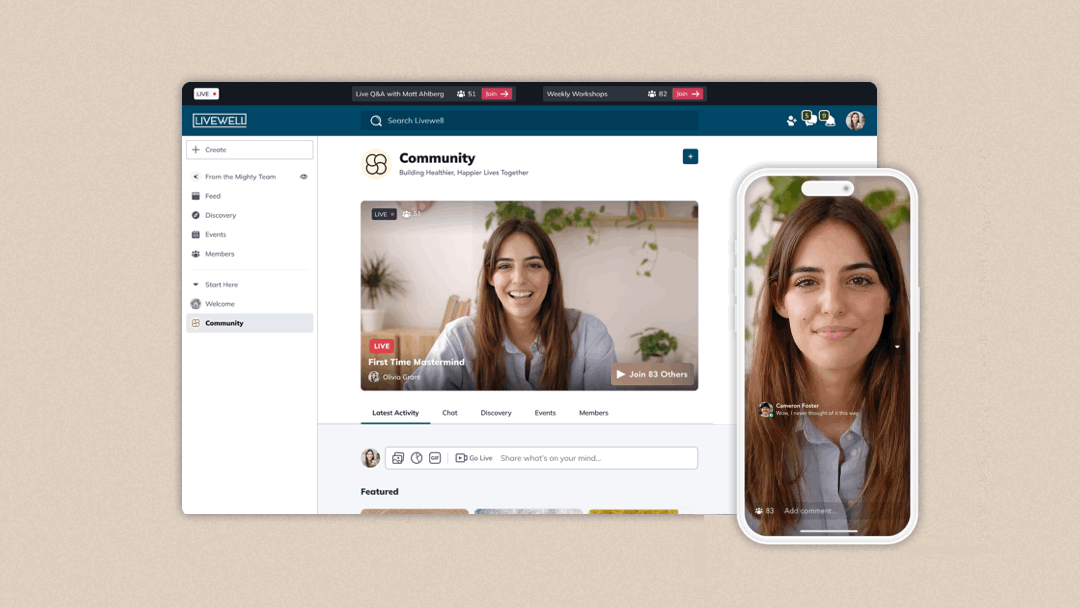
31 Community engagement ideas
These are some community engagement ideas. Don't forget, if you haven't read our post on community engagement strategies, you might want to start there.
1. Customize the new member experience
Okay, let's talk about the most important point in a community member’s journey: their first few minutes, hours, and days in a community.
This is the scary point for your new member. It's like being the new kid at school. It seems that everyone else knows each other and knows what's going on, and it can be intimidating to jump in.
That's why you need an amazing new member experience.
You want to make sure that every single person who comes into your community knows how and where to get started.
You want to invite them into discussions, make them feel welcome, show them where things are and what's possible, and let them know that you are there to help.
In an online community, this can be achieved through building a great digital new member experience.
For example, within a Mighty Network, we created a new member checklist that you can customize and make your own. Every new member sees this, and it walks them through prompts like setting up their member profile, saying hello in the community, asking their first question, or RSVPing to their first live event.
We have free training on building a magical new member experience in our Mighty Community!
2. Have real conversations
A 2013 study of online communities found that member retention was impacted by four things: "communication breadth, depth, responsiveness, and cross-posting."
Information exchange isn't the only reason why people join online communities--but it's often a part.
Prompt real conversations that go deep and include a lot of value.
3. Charge more
It's counterintuitive, but our numbers don't lie. Our analytics show that communities that charge for membership have an 11-37% higher engagement rate.
Not every community needs to or can have a membership fee, but we find that the old adage holds up: "people value what they pay for."
4. Create subgroups
We've found that subgroups (AKA spaces) have a superpower in an online community. They basically create more intimate, focused spots where it's easier to engage. If a member has a choice between posting in the main community for thousands of people to see, or posting in a subgroup with a handful of members they know and trust, the decision is easy.
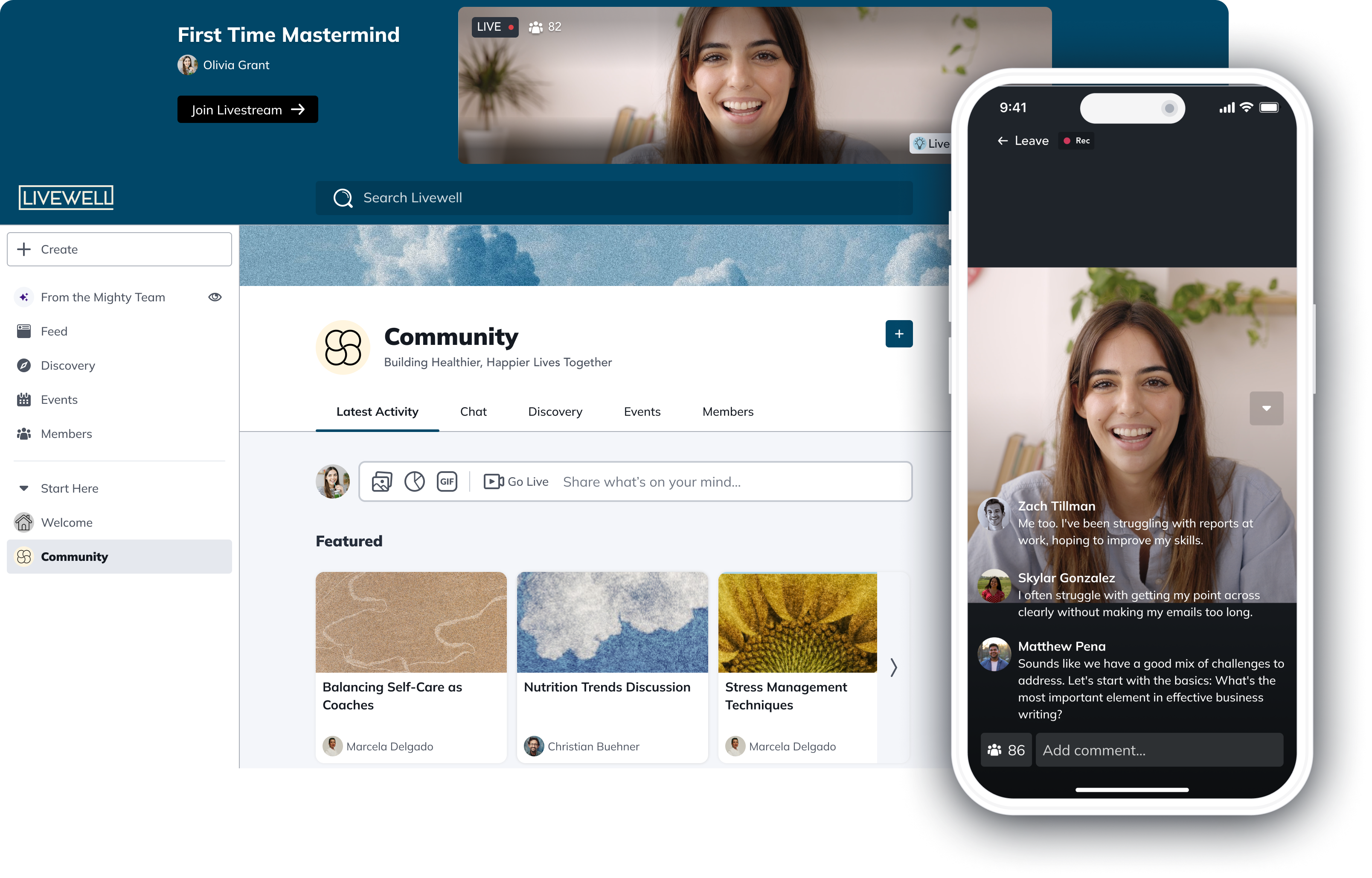
Subgroups can also be used for events, and as this group of people get to know each other, it increases their comfort. And it can also boost their sense of belonging in the overall community too.
Subgroups are a proven strategy for any brand managing large member bases.
5. Go live… a lot!
We love live streaming. Whether it's a planned event or an unexpected surprise, live streaming adds the element of the real to your virtual community.
Live streaming might come with the occasional "um", but don't get hung up on that. With all the perfectly scripted social media out there, a little bit of humanity is welcome.
You can talk about what you're learning, interview a community member or an outside guest, or hold a question and answer time or an AMA.
Those butterflies you get before live streaming are totally normal. It can be a bit scary to live stream if you've never done it before. But trust us, if you rip off the Band-Aid you'll love what happens next. Increased engagement.
And by the way, your presentation skills will get better in time. And those butterflies will go away. Just give it a try!
6. Use low lifts
We mentioned above that lurkers still feel a sense of belonging in a community. But that same research shows lurkers have a lower retention rate than engaged members.
How do you get lurkers out of the shadows?
Sometimes, low lift activities can do it.
For example: Creating a post can be intimidating. Commenting on a post is a bit less scary. Liking a post is probably the easiest.
How can you get people engaged without asking too much?
Ask simple questions. (e.g. What's 1 word you'd use to describe yourself)
Use polls. They're anonymous, but still help people engage.
Ask for a response during a live event. (e.g. "If you've ever struggled with this, type YES into the chat.")
7. Try a recommendation post
It's scary for members to post ideas and opinions, especially about things they don't know. Sometimes you can use psychology to get people sharing in their comfort area. People like to help, so asking for help as a Host can prompt people to engage.
And asking for help and recommendations is a great way to do this.
For example, "Share your best online resources for learning dance (for a dance community)." All they need to do is drop a link into the comments.
Shy members can share content that's been meaningful to them, without needing to create their own posts.
8. Email updates
Okay, so as you think about your community engagement strategy, think about the role that email can play.
One of the great things about an awesome community platform is that it should integrate with email. (For example, Mighty Networks has a built-in ConvertKit integration).
You don't need to be emailing your members every single day. But you can email updates, or let people know about events. If people have been away from the platform for a while, it can be a good strategy to bring them back.
And when life gets busy, which it does, a weekly roundup of what's happened in your community can help people stay connected and prepare them to jump back in.
Try Our Community Name Generator
Our AI engine is here to help you create a community name that feels like magic. Just share a few words about who your community is for and we’ll get to work.
Examples: coaching clients, meditation novices, vegan chefs, dog lovers, aspiring entrepreneurs, etc.
The names generated by Mighty Co-Host™ are examples only and may be used by other businesses or subject to third-party rights. For more information, check our Terms
9. Go app first
Community engagement for an online community will always interplay with the technology you use. Email notifications are a great reminder for people to come back to a community and engage.
But there's nothing like a community mobile app.
Community apps fundamentally change community behavior. They come with notifications and updates, building the community habit. All in the palm of your hand.
Building an app for your community increases engagement.
10. Incorporate play
Communities should be fun. Sometimes, we have a tendency to get too serious, especially if people are paying for community membership. You might be feeling the pressure to try to deliver a really serious experience that feels… "professional."
There's a time and a place for that. And we’re not saying that you shouldn’t be professional.
But being “professional” doesn’t necessarily mean being serious all the time. A great community should also come with some fun built-in.
If you can get your members laughing together, connecting over the vulnerability of being silly and playful, you will be building some awesome member experiences.
Try incorporating some fun things. A virtual game show. Karaoke. Things that break your community out of the serious and build engagement with fun.
If you are looking for some fun virtual event ideas, we have a full list here.
11. Know your Big Purpose
There's something that we recommend doing at the planning stage of your community, during Community Design™. But even if you skipped it at the planning stage, it's not too late to do these exercises now.
We call it your community's Big Purpose. Your Big Purpose outlines who your community is for, and what you will help them do. It looks like this.
This is so important to us that we've actually built a Big Purpose generator into each community that's built on Mighty. Our Mighty Co-Host™ community engine can instantly create a Big Purpose from only a few words.
By the way, we have totally free training on finding both your Ideal Members and your Big Purpose in our mighty community.
12. Your Ideal Member
Every community needs two things. First of all, it needs an Ideal Member. You need to know exactly who your community is for. Be as specific as possible about these members; know what they're like, their hopes and their dreams, and what they care about.
If you can create a specific Ideal Member, it will help your community engagement. Because instead of throwing stuff at the wall to see what sticks, you can just focus on helping your Ideal Members solve the problem that they have. It's a recipe for members that show up and get involved.
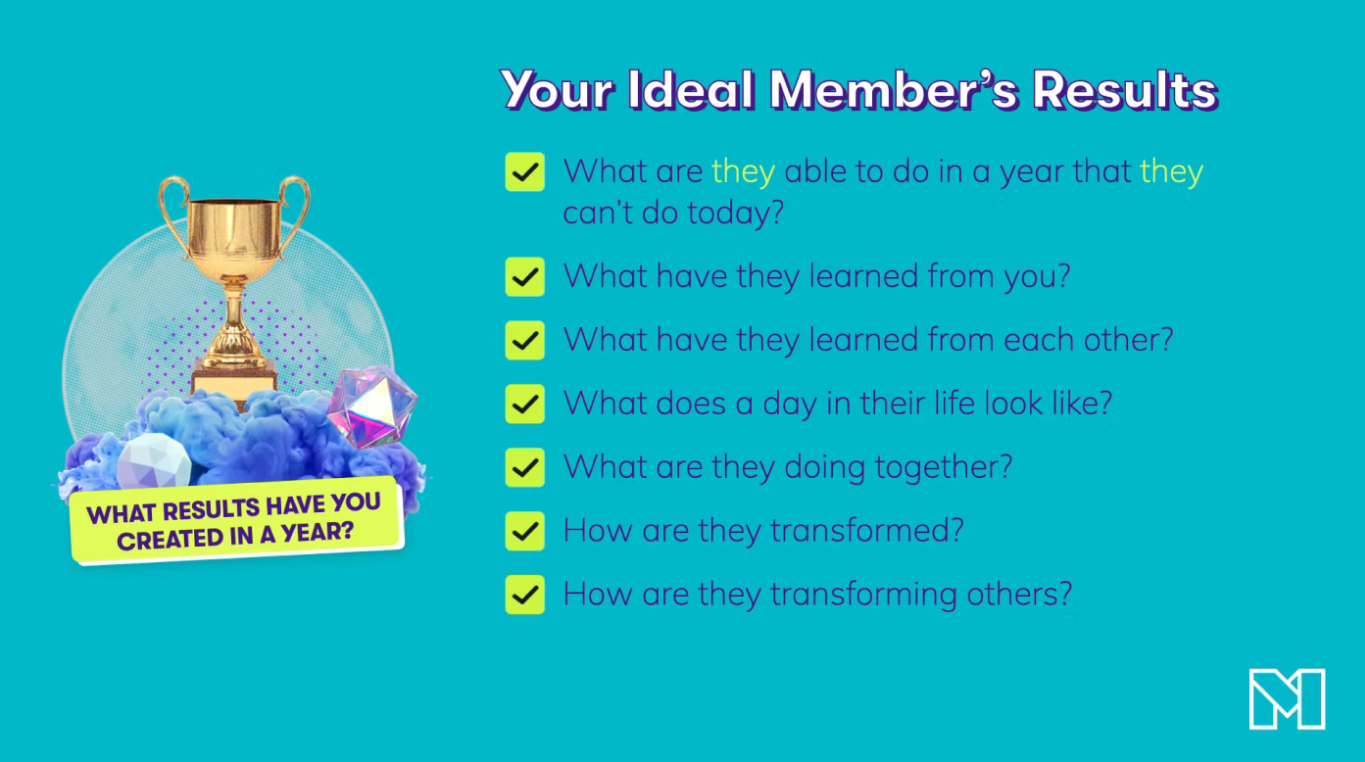
13. Fill out member profiles
Creeping member profiles is one of the best ways to figure out who's in a community. Member profiles can be sort of annoying for some members--but the results are worth it. When members can find people like them, community engagement gets WAY better.
Make sure you have prompts to fill out profiles as members create a community. We've also built in a "profile assist" into Mighty Co-Host™ that will help generate a profile for members who are lacking inspiration.
And Mighty Co-Host™ can also help you find members who share things in common with you.
14. Monthly themes
This is another part of what we teach in Community Design™. Monthly themes can be an awesome way to focus your discussions for the month and get members excited about what's coming up.
Monthly themes should always be connected to...
15. Yearly plans
We like to talk about a "Year in the Life" of a community. This is the big picture.
Where will your members be in a year because they joined your community?
That's the vision you're supporting with everything you do.
Create a yearly plan and share it with your members. Help them know where you're going.
This can promote engagement because engagement is no longer just something they do for no reason. Members can have a clear understanding of what's at stake if they go all-in (they'll reach their goals).

16. Moderate that thing
Having great community engagement isn't just about what's in your community. A big part of it is that there are some things your community shouldn’t have.
And that's where a solid community moderation strategy comes in.
Your members should feel safe in your community.
They should know that they won't be bullied or victimized.
They should trust that they won't see posts that are racist, sexist, homophobic, or some other form of discrimination.
So if you want to create a community where people feel safe, you need to build a good moderation strategy. Let your members know what the expectations are, and refer back to them regularly.
Don't be afraid to use the moderation tools on your community platform to flag or block offensive content. And think about choosing some of your most engaged, loyal members to help you out with the task of moderation.
Moderation isn't something that is super exciting at the outset. Nobody gets their thrills from sitting down and writing out rules.
But trust us, the psychological safety of your community members is worth it. And when people feel safe, they are way more likely to engage.
17. Build rituals
Imagine you could go back in time to those human communities that existed thousands of years ago. When our ancestors sat around campfires. What was it that made those communities stick together?
A big part of community bonding was the power of rituals. Rituals were used to mark belonging in the community. They were used for major life transformations, like the rites of passage between being a child and being an adult. Or, they were used to mark the passage of time, the weeks, months, and years.
Your community can benefit from the power of rituals too. As you go through the life of your community, pay attention to moments that deserve to be ritualized.
Maybe it's something you tried once for new members that you want to keep doing for everyone - like the new member experience we talked about above.
Maybe once a year you have a certain type of community event, something everyone looks forward to.
Maybe it’s just the monthly community happy hour.
By creating these moments in time, naming them, and making them special, you are creating rituals. And that's just something humans have always done, making rituals a powerful community engagement tool.
18. Ask questions
When we've studied communities, there's one thing again and again that creates engagement. It's not a secret.
The thing is… questions!
Questions draw members in.
Questions ask something of them.
Questions get them to pull on their own experience and knowledge, something we all get excited about doing.
In short, questions might be the ultimate secret to member engagement.
In fact, we care about questions so much that a while back we created this awesome guide for 1,000 discussion questions you can use to get your community talking. Download it for free here.
19. Introduce people
Have you ever gone to a party where you don't know anyone? How much of a relief is it when the Host introduces you?
It's the same in an online community. It can be scary to come into a new place with people who all seem to know each other.
One simple solution is to introduce people. This can work for new members. But it can also be a great tool for old members who aren't engaging much.
A good conversation with a new friend works wonders.
Using software for introductions
You can obviously introduce people manually. But we've been accomplishing this through software too--Mighty Co-Host™ can automatically match members with people who they share things in common with.
It's one of the fundamentals of an approach to community building we call "people magic," creating software that helps communities run themselves.
20. Assign a welcome committee
Often, community Hosts are afraid to ask members for things. Especially if members have paid a membership fee.
But the truth is, members often love to be asked.
One community Host told us that he was surprised when his members came to him and asked, "Why aren't you giving us more to do?" He assumed that, since they were paying members, he had to deliver an experience to them. The truth is, they wanted to feel like part of it.
Empower your members to welcome new members and reach out to old ones who are inactive.
This has the double magic of making those supermembers feel values, and helping lapsed or new members get integrated.
21. Go on quests
There's something else we've built into Mighty Networks that we are really excited about. Quests. Just like the knights of old, quests take your community on a challenge together.
We think about quests as encompassing four things:
Courses
Experiences
Challenges
Collabs
For example, if two community members worked together to create a podcast--that's a collaboration.
We've found that it's fun to think about these as quests, because a quest keeps the focus on a journey. These aren't just activities for activity's sake. These are journeys of transformation.

22. Unscript
Here's another tip to get at the magic of community engagement.
Unscript.
As community managers, it can be tempting to control everything. To scrub everything. To make everything look perfect. But ask anybody who's spent any time in a community and they'll tell you that the most powerful moments are often the ones nobody expects. The unscripted ones.
It might be the live stream where the guest can't come on and the resulting discussion ends up being more powerful than that session would have been.
It might be the moment where a community member breaks down in tears as you watch the others jump in to support and encourage them.
Obviously, there's no way to plan for unscripted moments. That would defeat the purpose.
But do create space and time to be together in ways that aren't perfectly scripted, and be prepared to watch the magic happen.
23. Empower your best people
Community, as the word suggests, shouldn't be done alone. And leadership of a community doesn't have to be done alone either.
One of the secrets to amazing community engagement is to bring people in and not try to be a one-person show. It might mean formally hiring a community manager. But often it just means empowering the members who are there.
You can do this with things like an Ambassador Program, that rewards your members for inviting new members.
Or, you might promote your best members to co-Hosts or moderators. These can be paid or unpaid positions, and you might be surprised to find that some people who are invested in your community love the opportunity to take on a leadership role and go deeper.
24. Host virtual events
Events have a vibrant energy of their own. And hosting an event in a community creates buzz and a real-time engagement communities don't always have.
Bring people together. Get them talking. And watch the magic happen.
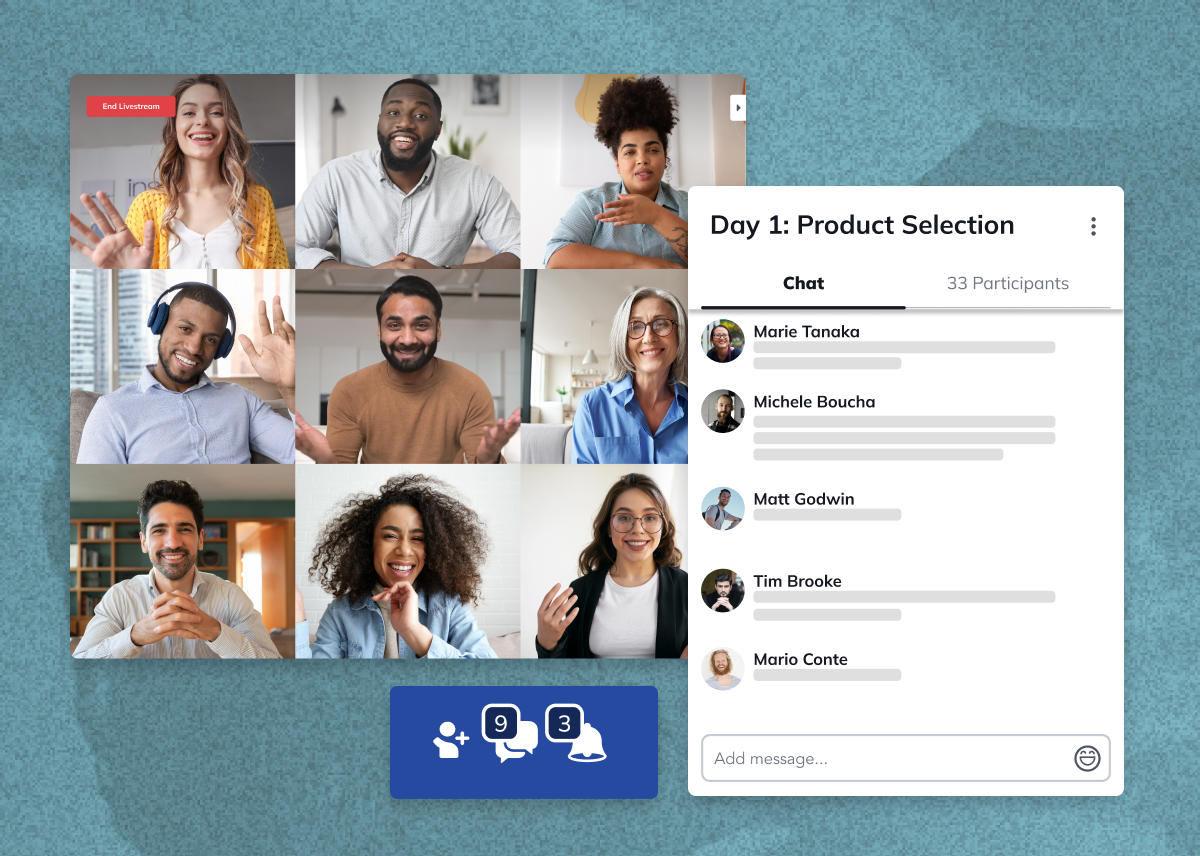
25. Host in-person events
YouTuber Drew Binsky has traveled to every country in the world. And he creates videos sharing what he's learned from them.
This spun off into some amazing live events for members of his Just Go app.
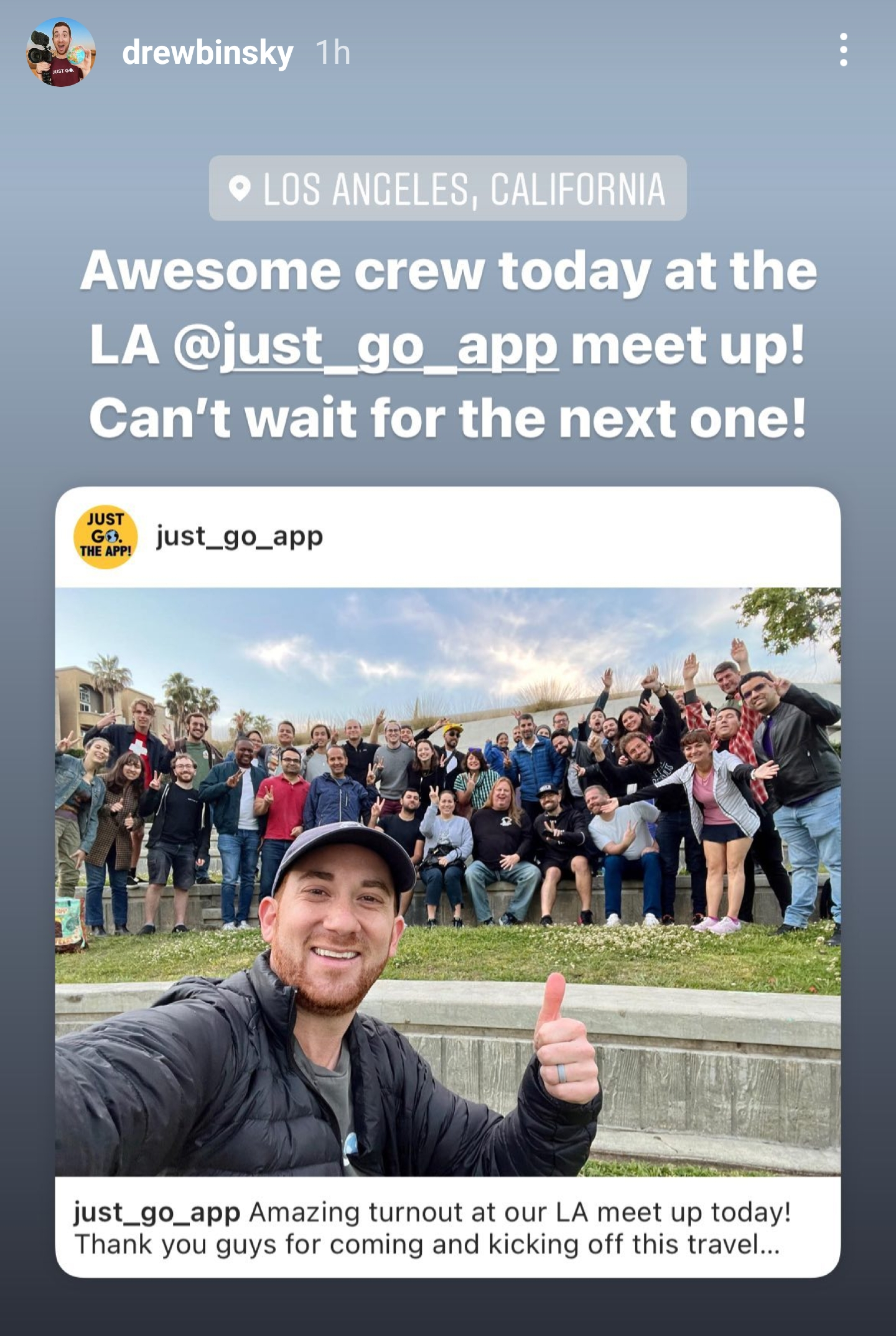
Even for an online community, an in-person event can be incredible. In fact, it can be even better than random events--like a yearly conference.
Here's why.
A live event for an online community brings together PEOPLE WHO KNOW EACH OTHER. It's like a gathering of old friends.
And that's a community engagement tool like nothing else.
26. Invite high-profile guests
Often community Hosts have a cool advantage other members may not--many Hosts know or are familiar with leaders in their particular niche.
Inviting these leaders to come as guests for your community, whether for a livestream or live event, can create really interesting content for your members.
And--bonus--you're helping your members get access to someone they might not otherwise get to experience, so that's a perk of being in your community.
27. Spotlight members
One of the coolest things about community management can be spotlighting members.
Whether it's celebrating member accomplishments or even just picking a different member to introduce and feature every week, it's a great way to get more people engaged in different ways.
28. Spotlight members on social channels
Spotlighting members can (and should) happen in the community first. But if your brand has relevant social media channels with engagement there, spotlighting active community members outside of the community can build awareness.
It also helps members feel important.
29. Incentivize engagement
One cool way to increase member engagement is to actually reward them for it. There are a lot of ways to gamify engagement, but this can include:
Celebrating top members
Giving rewards and prizes for engagement (e.g. discounts to products or a private coaching session)
Giving engagement members positions in leadership (e.g. moderators or co-hosts)
If you want an awesome example of this in action, go look at Apple's brand community. They run an entire community with volunteers, gamifying and adding cool perks for members who engage the most.
30. Check your stats
Any community platform worth its salt should give you lots of data to work with--helping you understand where people are engaging and why.
Use this data to your advantage.
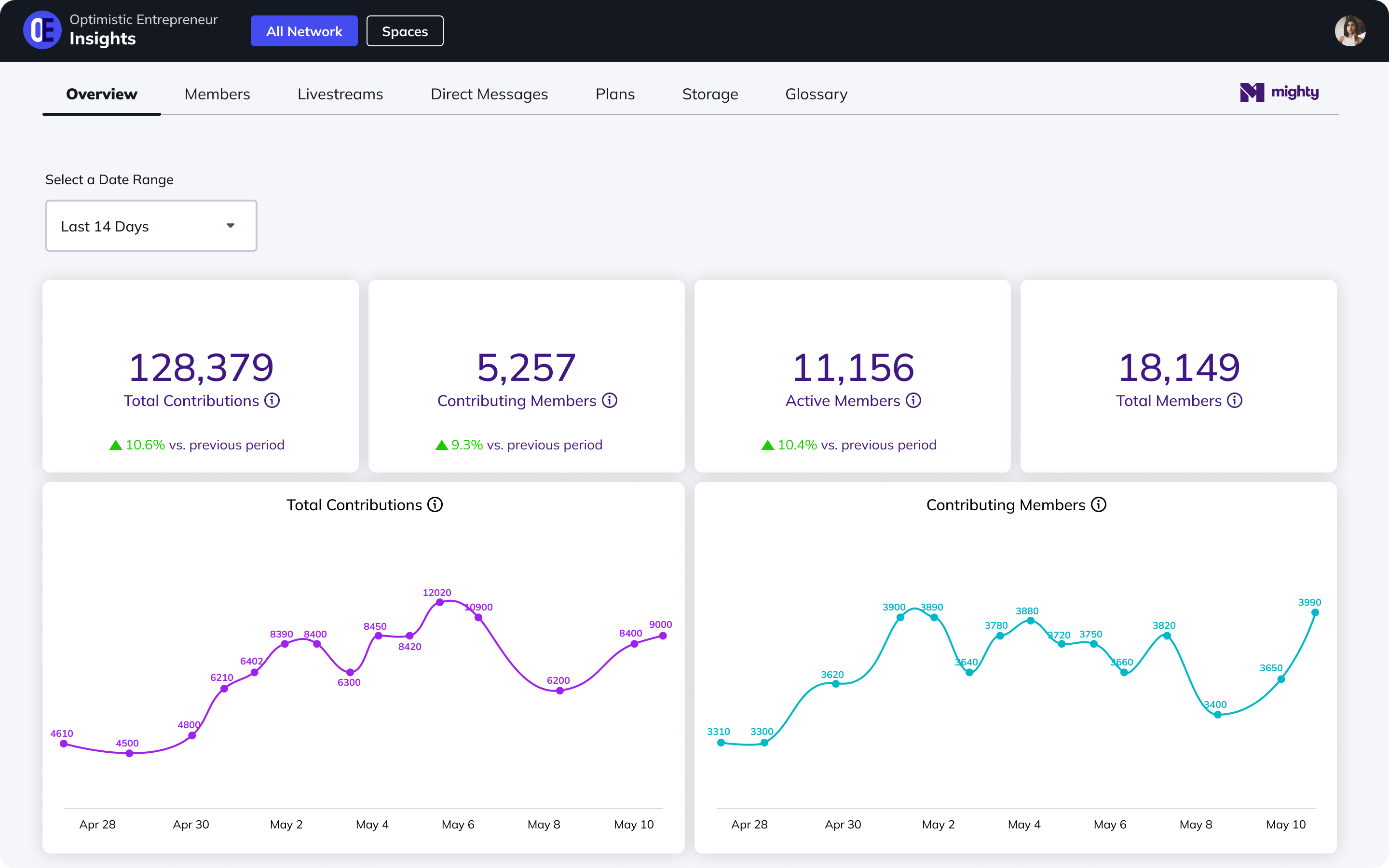
31. Use a great platform
Finally, choose a great platform to host your community on. We care a lot about communities. And too many of them fail because of the software that Hosts choose.
When you spend more time wrestling with software than talking to members, you're not going to see great community engagement.
Choose a software that gets out of the way and lets you do your best work.
Ready to start?
If you are looking for an awesome platform to build your community on, come try Mighty Networks! Mighty is G2's #1 ranked community platform, bringing together content, community, courses, and commerce! And with customizable spaces that can hold forums, messaging, live streaming, courses, integrated events, and more, it's a powerful tool for community engagement.
You can charge in 135 different currencies or even token-gating, and you can bundle any and all of these. And it comes with an awesome app that your members will love.
It's got a built-in ConvertKit integration. And Mighty Co-Host™ gives you an AI partner to take care of a lot of the community management things we've talked about here: it can automate landing pages, help with posts, introduce members to each other, and more!
You can try it totally free for 14 days--no credit card required!
Ready to start building your community?
Ready to start building your community?
Start a free 14-day trial to explore Mighty—no credit card required.
More like this
Join Mighty Community
Learn the principles of Community Design™ (and see them in action) alongside thousands of creators and entrepreneurs. It's free to join!

Communities & Memberships
Community Platforms
Managing a Community
Building a Community
Growing a Community
Monetizing a Community
Content Creation
Online Courses
Creating a Course
Teaching a Course
Course Platforms
Selling a Course
Creators & Entrepreneurs
Monetization
Content Creation
Starting a Business
Website Builders
Creating & Managing a Website
Events
Event Platforms
Hosting & Marketing Events
Branded Apps
Creating a Mobile App
Coaching Apps
Community Apps
Coaching
Mastermind Groups
Starting a Coaching Business
Coaching Platforms
Filter by Category
Communities & Memberships
Online Courses
Creators & Entrepreneurs
Events
Branded Apps
Coaching
Build a $1 Million Community
This free masterclass went viral—sign up to learn why.













